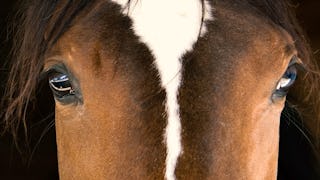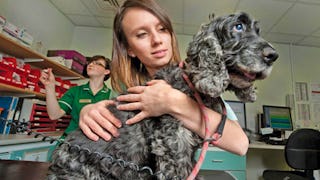Why is the experience of going to the vets a negative one for some animals? Is it the anticipated pain, the way the place smells, the colour of the waiting room, the noises coming from the consulting room, or something else?



(30 reviews)
Recommended experience
What you'll learn
Describe the theories and concepts of animal welfare and animal behaviour.
Explore different animal welfare approaches, techniques, and skills in different clinical areas.
Investigate how to implement good animal welfare practice in a clinical setting in relation to specific species.
Details to know

Add to your LinkedIn profile
5 assignments
See how employees at top companies are mastering in-demand skills


Earn a career certificate
Add this credential to your LinkedIn profile, resume, or CV
Share it on social media and in your performance review

There are 4 modules in this course
In this first week, we look at animal welfare as a science, how we can use evidence to make objective measures to determine whether an animal is experiencing positive or negative welfare, and why it is so important in the veterinary clinic. We’ll also look at what constitutes normal cat, dog, and rabbit behaviour, what motivates canine aggression and what we can do if an owner reports aggressive behaviour in their dog.
What's included
17 videos4 readings2 assignments4 discussion prompts
This week we are examining what owners can do to help their animal companions better cope in the clinic BEFORE they arrive, what clinic staff can do to help reduce anxiety for the pet once they have entered the building, and we will define the terms ‘trigger stacking’ and ‘building a welfare bank account’. How to improve patient welfare and reduce stress in the waiting room and consulting room will also be explored this week by examining the latest scientific evidence, and we will also discuss the techniques and benefits of low stress handling, how to perform a low stress examination on a cat, dog, and rabbit, and how to handle a cat or dog that is behaving aggressively.
What's included
14 videos2 readings1 assignment3 discussion prompts
This week we are going to delve into what we can do to make the preparation room, also known as the treatment room, less worrying for our patients. We will discuss pre-emptive, multi-modal analgesia prior to going for surgery, and the difference between light anaesthesia and nociception. We’ll also consider what we can do to make the operating room, and the kennels or recovery area more welfare focussed, and the ways in which we can improve the clinic experience for the long-term inpatient.
What's included
8 videos3 readings1 assignment3 discussion prompts
This week we are talking about pain in rabbits, cats and dogs – how to recognise it, how to score it, how to treat it, and why, physiologically, treating acute pain is so vital. We’ll also study pain pathways, multimodal analgesia, the post operative advice we can give to owners to ensure good welfare continues when they take their animal home, and what owners can do to enrich the lives of their pets if they must be strictly rested for an extended period of time.
What's included
14 videos4 readings1 assignment4 discussion prompts
Instructors

Offered by
Explore more from Animal Health


The University of Edinburgh


University of California, Davis


University of Colorado Boulder


The University of Edinburgh
Why people choose Coursera for their career




Learner reviews
30 reviews
- 5 stars
96.66%
- 4 stars
3.33%
- 3 stars
0%
- 2 stars
0%
- 1 star
0%
Showing 3 of 30
Reviewed on Jan 2, 2025
This course was great - interesting, with lots of practical advice. Would recommend to anyone working in veterinary practice.
Reviewed on Jul 25, 2024
Simply amazing, very complete, very clear explanations,absolutely excellent. Highly recommended, all vets that love their patients and want their clinics to be extraordinary should take this course!
Reviewed on Aug 23, 2024
Learned a lot about animal behavior in clinics! Overall loved the course!
New to Animal Health? Start here.

Open new doors with Coursera Plus
Unlimited access to 10,000+ world-class courses, hands-on projects, and job-ready certificate programs - all included in your subscription
Advance your career with an online degree
Earn a degree from world-class universities - 100% online
Join over 3,400 global companies that choose Coursera for Business
Upskill your employees to excel in the digital economy
Frequently asked questions
Access to lectures and assignments depends on your type of enrollment. If you take a course in audit mode, you will be able to see most course materials for free. To access graded assignments and to earn a Certificate, you will need to purchase the Certificate experience, during or after your audit. If you don't see the audit option:
The course may not offer an audit option. You can try a Free Trial instead, or apply for Financial Aid.
The course may offer 'Full Course, No Certificate' instead. This option lets you see all course materials, submit required assessments, and get a final grade. This also means that you will not be able to purchase a Certificate experience.
When you purchase a Certificate you get access to all course materials, including graded assignments. Upon completing the course, your electronic Certificate will be added to your Accomplishments page - from there, you can print your Certificate or add it to your LinkedIn profile. If you only want to read and view the course content, you can audit the course for free.
You will be eligible for a full refund until two weeks after your payment date, or (for courses that have just launched) until two weeks after the first session of the course begins, whichever is later. You cannot receive a refund once you’ve earned a Course Certificate, even if you complete the course within the two-week refund period. See our full refund policy.
More questions
Financial aid available,



